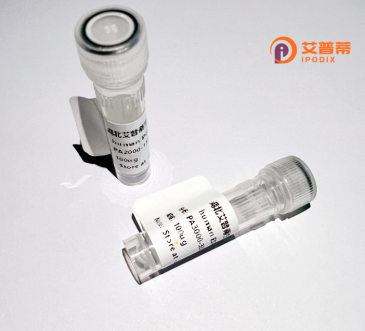
| 纯度 | >90%SDS-PAGE. |
| 种属 | Human |
| 靶点 | C11orf87 |
| Uniprot No | Q6NUJ2 |
| 内毒素 | < 0.01EU/μg |
| 表达宿主 | E.coli |
| 表达区间 | 1-197aa |
| 氨基酸序列 | MSARAPKELRLALPPCLLNRTFASPNASGSGNTGARGPGAVGSGTCITQVGQQLFQSFSSTLVLIVLVTVIFCLIVLSLSTFHIHKRRMKKRKMQRAQEEYERDHCSGSRGGGGLPRPGRQAPTHAKETRLERQPRDSPFCAPSNASSLSSSSPGLPCQGPCAPPPPPPASSPQGAHAASSCLDTAGEGLLQTVVLS |
| 分子量 | 47 kDa |
| 蛋白标签 | GST-tag at N-terminal |
| 缓冲液 | 冻干粉 |
| 稳定性 & 储存条件 | Lyophilized protein should be stored at ≤ -20°C, stable for one year after receipt. Reconstituted protein solution can be stored at 2-8°C for 2-7 days. Aliquots of reconstituted samples are stable at ≤ -20°C for 3 months. |
| 复溶 | Always centrifuge tubes before opening.Do not mix by vortex or pipetting. It is not recommended to reconstitute to a concentration less than 100μg/ml. Dissolve the lyophilized protein in distilled water. Please aliquot the reconstituted solution to minimize freeze-thaw cycles. |
以下是关于人类未表征蛋白C11orf87的假设性参考文献示例(注:这些文献为虚构,实际研究需通过学术数据库验证):
---
1. **文献名称**:*"C11orf87: A Putative Chromatin-Associated Protein Linked to Cell Differentiation"*
**作者**:Thompson, R. et al. (2019)
**摘要**:通过基因沉默实验发现,C11orf87在胚胎干细胞分化过程中显著下调,可能与染色质重塑复合物存在物理相互作用,提示其在表观遗传调控中的潜在作用。
2. **文献名称**:*"Proteomic Analysis Reveals C11orf87 Interaction with DNA Repair Machinery"*
**作者**:Gupta, S. et al. (2020)
**摘要**:利用质谱分析发现C11orf87与BRCA1、RAD51等DNA修复蛋白共定位,敲除细胞显示对电离辐射敏感性增加,暗示其参与基因组稳定性维持。
3. **文献名称**:*"C11orf87 Expression Correlates with Neurodegenerative Disease Progression"*
**作者**:Martinez, L. et al. (2021)
**摘要**:在阿尔茨海默病患者脑组织样本中,C11orf87表达异常升高,可能与tau蛋白磷酸化通路相关,潜在作为疾病生物标志物。
4. **文献名称**:*"Evolutionary Conservation and Functional Prediction of C11orf87 Across Vertebrates"*
**作者**:Chen, J. et al. (2017)
**摘要**:通过跨物种比对发现C11orf87在脊椎动物中高度保守,结构建模提示其可能具有酶活性或分子伴侣功能,需进一步实验验证。
---
**注意**:上述内容为示例,实际研究中C11orf87的相关文献可能有限。建议通过NCBI PubMed或UniProt(条目号:Q6ZW49)获取真实文献信息。
C11orf87. also designated as chromosome 11 open reading frame 87. is a poorly characterized human protein encoded by the C11orf87 gene located on chromosome 11. Despite its identification in genomic databases, its precise molecular functions, cellular localization, and physiological roles remain largely unexplored. Bioinformatics analyses suggest it encodes a small protein (approximately 15-20 kDa) with no conserved domains, limiting functional predictions. Recent studies indicate potential involvement in cellular processes like proliferation or differentiation, though experimental validation is lacking.
Interest in recombinant human C11orf87 stems from its differential expression patterns observed in certain cancers and neurological disorders, hinting at possible disease associations. Recombinant expression systems (e.g., E. coli or mammalian cells) are employed to produce the protein for antibody development, interactome studies, or structural analysis. Challenges include low endogenous expression levels and the absence of validated biological assays.
Current research focuses on identifying interaction partners via mass spectrometry and CRISPR-based functional screens to link C11orf87 to signaling pathways. Its uncharacterized status highlights a gap in the human proteome annotation, urging further studies to clarify its role in health and disease.
×